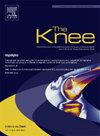前交叉韧带断裂后的步态适应是性别特异性的
IF 2
4区 医学
Q3 ORTHOPEDICS
引用次数: 0
摘要
背景:对于前交叉韧带缺陷(ACLD)膝关节患者,有各种步态运动学适应的报道。然而,据我们所知,没有研究将它们的运动学与性别匹配的对照组在整个步态周期内进行比较。因此,这项回顾性研究旨在确定ACLD患者和性别匹配的对照组之间步态运动学的差异。方法合并两个数据库,分别比较44例男性损伤(ACLD-M)和27例女性损伤(ACLD-F)与32例健康男性(Control-M)和37例健康女性(Control-F)的膝关节步态运动学。参与者以舒适的速度在跑步机上行走,他们的动作使用KneeKG®系统进行记录。结果ACLD-M组在多个步态周期亚阶段内翻角明显降低(17-32%、57-73%和86-97%);所有p <;0.05),胫骨外旋从67-86%的步态周期增加(p <;0.001)与Control-M组相比。ACLD-F组膝关节屈曲度增加1-53% (p <;0.001)和95% - 100% (p <;0.05),外翻增加1 ~ 65% (p <;0.001)和94% - 100% (p <;与Control-F组相比,步态周期缩短了0.05)。结论:本研究揭示了ACL断裂后的性别特异性适应。女性在站立阶段表现出更多的矢状面和额平面的步态适应,而男性在站立和摇摆的子阶段表现出额平面的适应,以及在摇摆初期和中期的胫骨外旋转。这些发现表明,ACL损伤的运动学和损伤后的康复应该是性别特异性的。证据水平III。本文章由计算机程序翻译,如有差异,请以英文原文为准。
Gait adaptations following anterior cruciate ligament rupture are sex specific
Background
Various gait kinematic adaptations have been reported for patients with an anterior cruciate ligament deficient (ACLD) knee. However, to our knowledge, no study has compared their kinematics to their sex-matched controls for the entire gait cycle. Therefore, this retrospective study aims to identify differences in gait kinematics between ACLD patients and sex-matched controls.
Methods
Two databases were merged in this study, comparing knee gait kinematics of 44 injured males (ACLD-M) and 27 injured females (ACLD-F) with 32 healthy males (Control-M) and 37 healthy females (Control-F), respectively. Participants walked on a treadmill at a comfortable speed, and their movements were captured using the KneeKG® system.
Results
The ACLD-M group showed a significantly decreased varus angle at several gait cycle sub-phases (from 17–32%, 57–73% and 86–97%; all p < 0.05) and an increased external tibial rotation from 67–86% of the gait cycle (p < 0.001) compared to the Control-M group. The ACLD-F group exhibited increased knee flexion from 1–53% (p < 0.001) and from 95–100% (p < 0.05) and increased valgus from 1–65% (p < 0.001) and from 94–100% (p < 0.05) of the gait cycle compared to Control-F group.
Conclusion
Our study reveals sex-specific adaptations following ACL rupture. Women exhibited more gait adaption in the sagittal and frontal planes during the stance phase while men demonstrated adaptations in frontal plane for sub-phases of stance and swing, and external tibial rotation during initial and mid-swing phases. These findings suggest that ACL injury kinematics and rehabilitation after injury should be sex-specific.
Level of evidence III.
求助全文
通过发布文献求助,成功后即可免费获取论文全文。
去求助
来源期刊

Knee
医学-外科
CiteScore
3.80
自引率
5.30%
发文量
171
审稿时长
6 months
期刊介绍:
The Knee is an international journal publishing studies on the clinical treatment and fundamental biomechanical characteristics of this joint. The aim of the journal is to provide a vehicle relevant to surgeons, biomedical engineers, imaging specialists, materials scientists, rehabilitation personnel and all those with an interest in the knee.
The topics covered include, but are not limited to:
• Anatomy, physiology, morphology and biochemistry;
• Biomechanical studies;
• Advances in the development of prosthetic, orthotic and augmentation devices;
• Imaging and diagnostic techniques;
• Pathology;
• Trauma;
• Surgery;
• Rehabilitation.
 求助内容:
求助内容: 应助结果提醒方式:
应助结果提醒方式:


